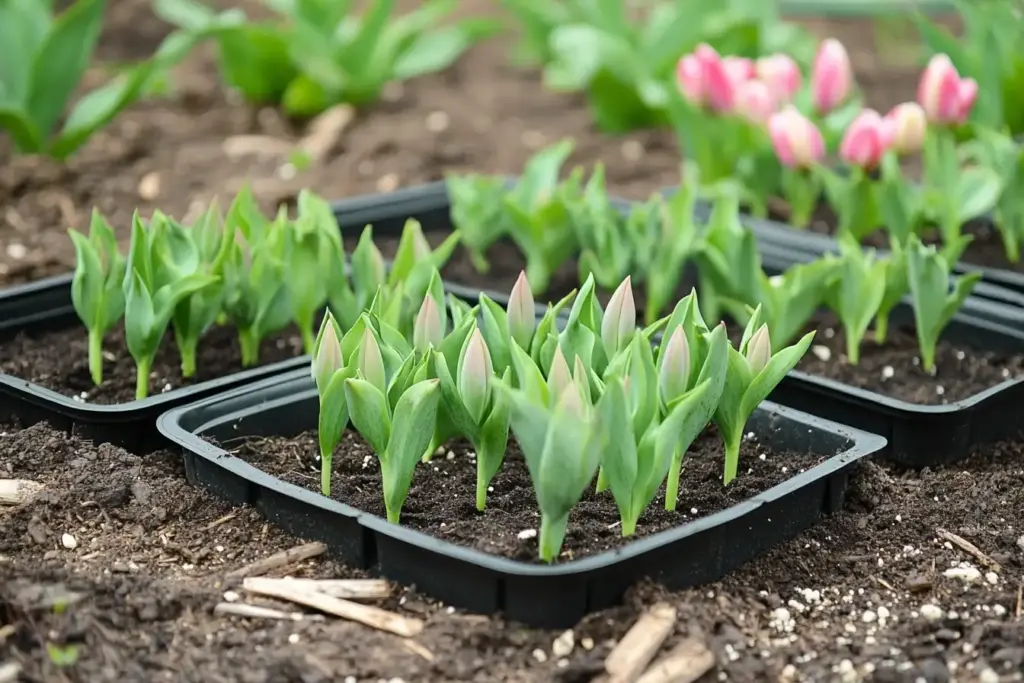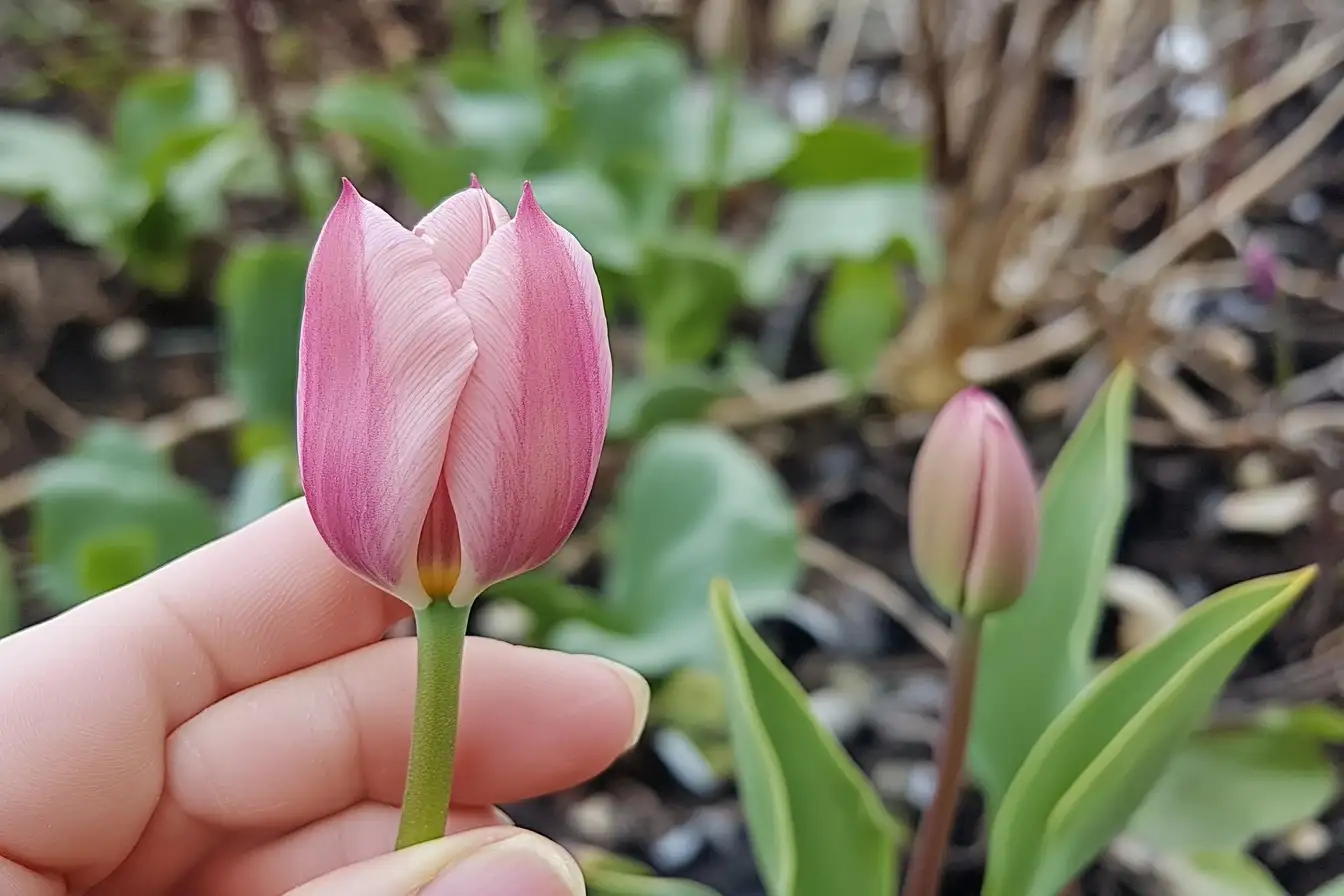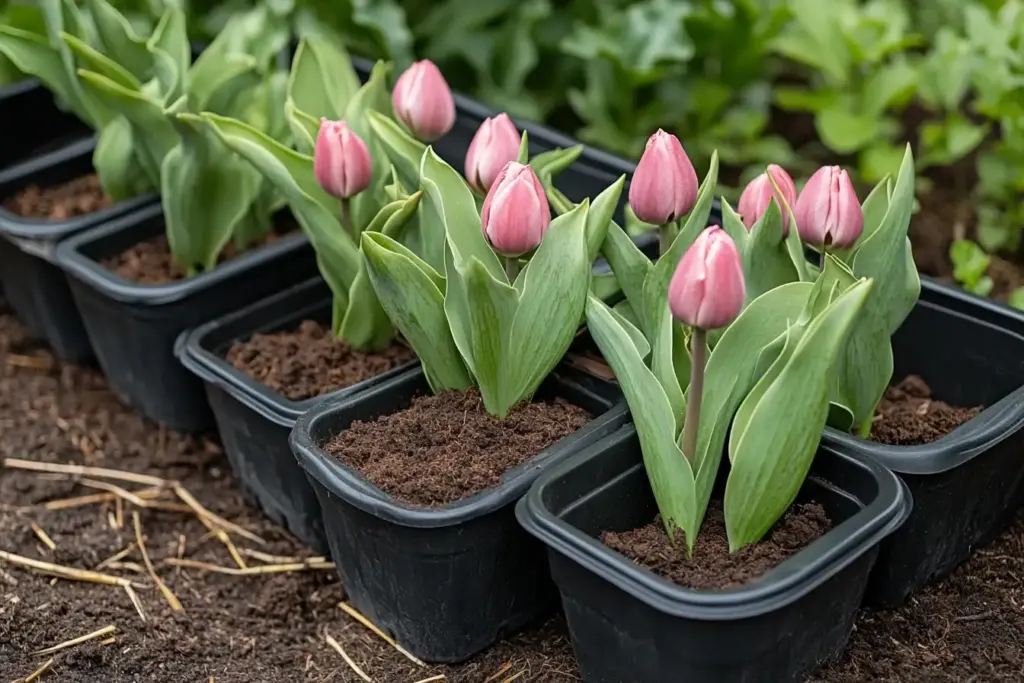Tulips are beloved spring beauties, often celebrated in garden beds and parks—but if you’re looking to grow tulips specifically for arrangements and bouquets, the process is surprisingly different. Growing tulips as a cut flower requires a unique planting style, harvesting method, and even a mindset shift. In this guide, you’ll learn how to cultivate stunning, long-stemmed tulips ideal for floral displays—while avoiding common mistakes that could ruin future blooms.
Whether you’re a home gardener or an aspiring flower farmer, this article will walk you through everything you need to know—from bulb choice to harvest—so you can fill your vases with vibrant tulips each spring.
🌼 Landscape Tulips vs. Cut Flower Tulips: What’s the Difference?
At first glance, all tulips might seem the same. But when it comes to their intended use, the way you plant, space, and treat the bulbs varies drastically depending on whether you’re growing them for landscape beauty or for floral arrangements.
🌳 Landscape Tulips
- Purpose: Grown to enhance your garden’s visual appeal
- Growth Style: Treated like short-lived perennials
- Spacing: Bulbs are spaced 4–6 inches apart
- Lifecycle: Left to bloom and fade naturally, with the hope they’ll return the next season
- Bulb Longevity: Most bulbs decline after 2–3 years and need replacing
Landscape tulips are usually allowed to live out their full cycle, which includes flowering, fading, and regenerating energy through their foliage. However, most won’t reliably rebloom unless you’re in a tulip-friendly climate.
✂️ Cut Flower Tulips
- Purpose: Grown for vase life, not longevity in the ground
- Growth Style: Treated as annuals
- Spacing: Planted tightly—think “eggs in a carton” style
- Harvesting: Entire plant is pulled before the bloom fully opens
- Bulb Use: Bulbs are discarded or composted after harvest
To get those long, florist-quality stems, you’ll need to harvest early—often before the flower fully opens. This means the bulb won’t photosynthesize and is no longer viable for future growth, so cut flower tulips are essentially one-time bloomers.
🚫 Why You Shouldn’t Use Landscape Tulips for Cutting (and What Happens If You Do)
Technically, you can cut tulips from your garden beds and put them in a vase—but it comes with trade-offs you’ll want to understand.
✂️ Cutting Means Sacrificing the Bulb
To get a long enough stem for arranging, you often need to cut at or near the base of the plant. Unfortunately, this removes the leaves along with the flower—leaves that are essential for photosynthesis and recharging the bulb.
Without leaves, the bulb can’t store energy for the next season. What does that mean for you?
- You likely won’t get blooms next year
- The bulb may only produce weak foliage, not flowers
- Even with care, reblooming may take years—if ever
One grower shared an experiment where 400 tulips were cut at ground level and left in the soil. After three full years, only two tiny blooms returned. Bottom line? It’s a gamble that rarely pays off.
🌿 Cut Flower Tulips Are Bred Differently
Tulips intended for cutting are bred to be treated as annuals—they’re harvested for the bloom and then composted. These bulbs aren’t meant to last beyond one show-stopping season.
If you’re looking for tulips that give you both cutting potential and a chance to return next year, you’ll need very specific varieties and careful harvesting (we’ll talk about those soon!).
🔄 Are Tulips Perennials or Annuals? Understanding Their True Lifecycle

🌎 Why Tulips Struggle to Naturalize
Tulips are native to parts of Central Asia, like Turkey and Iran, where they enjoy hot, dry summers and cold, wet winters. These conditions help them naturalize—meaning they return and bloom year after year.
But here’s the catch: most North American climates don’t mimic those exact patterns. In many U.S. regions, tulips behave more like short-lived perennials or even annuals, especially when used as cut flowers.
🌷 Best Tulip Varieties for Perennializing
If your goal is to enjoy blooms year after year and you live in the right climate, these tulip types offer the best shot at naturalizing:
- Darwin Hybrid Tulips – tall, sturdy, and fairly reliable
- Emperor Tulips – early bloomers with strong stems
- Triumph Tulips – classic shape and decent reblooming potential
However, even these varieties usually start declining after a few seasons unless conditions are ideal.
🧪 Important Note for Cut Flower Growers
Cut flower tulips are almost always bred for one-time bloom performance, not reblooming. They’re grown like an annual crop: plant, harvest, compost, repeat. Most public gardens and flower farms replant tulip bulbs every single year for consistent results.
🪴 Can You Grow Tulips in Pots?
The idea of tulips blooming on your balcony or porch is undeniably appealing—but container gardening with tulips comes with a few important caveats.
🤔 Mixed Opinions from the Experts
Some bulb suppliers discourage growing tulips in pots altogether, while others say it’s possible with extra care. Here’s what most experts agree on:
- Pots offer less insulation than ground soil, so bulbs are more vulnerable to extreme cold and moisture
- Tulip bulbs in containers often experience more stress, leading to smaller blooms or failure to emerge
- After blooming, potted tulip bulbs should not be reused
If you decide to go this route, be sure to:
- Use well-draining soil (to prevent rot)
- Choose deep containers to accommodate proper bulb depth (5–7” deep)
- Keep pots in a cool, sheltered area during winter
Still, even with best practices, it’s best to treat potted tulips as annuals, just like cut flower tulips. Once they bloom, toss the bulbs and start fresh next season.
🌷 Tulips That Work as Both Cut Flowers and Landscape Blooms
If you’re hoping to enjoy tulips in your garden and sneak a few stems for indoor arrangements, there are varieties that strike a decent balance—though not perfectly.
✅ Dual-Purpose Tulip Varieties to Try
Some tulips grow tall enough to be used as cut flowers while still leaving behind enough foliage to feed the bulb for next year’s bloom.
These are your best bets:
- Darwin Hybrid Tulips
Examples: ‘Apricot Impression’, ‘Mystic Van Eijk’- Long stems (often over 24”)
- Strong structure and classic tulip shape
- Can provide a 10–12” cut stem while preserving foliage
- Single Late Tulips
- Also known for tall stems and robust blooms
- Not as reliably perennial, but decent in the right climate
⚠️ The Catch: Most Tulips Aren’t Made for Both
The majority of tulip varieties bred for cut flower use are not suitable for reblooming, even if you leave foliage intact. They just aren’t built for that lifecycle.
So, while Darwin Hybrids offer a decent compromise, if your goal is a full vase of tulips every spring, you’ll get more predictable results by growing a separate, dedicated patch for cut flowers—and treating those as annuals.
🌱 How to Plant Tulips for Cut Flower Production (With Two Easy Methods)
When you’re growing tulips as cut flowers, your goal is simple: maximize bloom quality in a small space. That means planting densely, protecting bulbs, and setting them up for long, strong stems.
Here are two popular methods that professional growers use:
🕳️ 1. The Trench Method
Ideal for in-ground planting, this approach saves time and maximizes efficiency.
Steps:
- Dig a trench about 6 inches deep
- Place bulbs closely, like eggs in a carton—shoulder to shoulder, but not touching
- Pointy side up, of course!
- Backfill with soil and water well
- If your area gets sufficient rain and snow, no need to water again until spring
This tight spacing encourages vertical growth and helps tulips develop longer stems—a must for cut flower quality.
🌿 2. The Temporary Raised Bed Method
This method works great if you’re dealing with poor soil or vole pressure, and it’s also easier to disassemble after the season.
Steps:
- Rake the existing soil flat
- Build temporary bed sides (6–12 inches high) using wood, stone, or whatever you have
- Fill the bed with compost or a compost-soil mix
- Nestle bulbs tightly, again like eggs in a carton
- Cover and water thoroughly
After the growing season, you can break down the raised bed and reuse the soil elsewhere in your garden.
✂️ When and How to Harvest Tulips for Longest Vase Life
This might surprise you, but the goal when growing tulips for cutting is never to see a full bloom in the field. Weird, right? But there’s a good reason.
⏰ When to Harvest: The “Color Break” Stage
You want to cut your tulips when the buds are:
- Still closed
- Just starting to show color
- Firm to the touch (not floppy)
At this stage, tulips will continue to open gradually in the vase, giving you 7+ days of vase life—compared to just 3–5 days if you cut them when already open.
🌿 How to Harvest Like a Flower Farmer
- Gently pull the entire plant—bulb and all—out of the ground
- This keeps the stem as long as possible
- The bulb acts like a food reserve during storage
- Store the flower with the bulb attached
- Wrap stems in newspaper (keep upright or lay flat)
- Store dry in a cool, dark fridge or cooler for up to 2 weeks
This is a game-changer during warm springs when everything blooms at once—you can harvest in waves and store tulips until you’re ready to arrange them.
💧 Rehydrating After Storage
When you’re ready to use your tulips:
- Snip off the bulb
- Strip lower leaves
- Rinse stems and place in cool, clean water
If stems seem limp, don’t panic! Just:
- Recut the ends
- Wrap them tightly in newspaper
- Let them hydrate in cool water for 1–2 hours
The result? Upright, hydrated stems ready to dazzle.
🌟 Fun Fact: Tulip stems continue to grow after being cut!
You may notice your bouquet gets taller over time—feel free to trim them every few days.
📝 Tulip Planting Quick Guide
Whether you’re growing tulips for the garden or the vase, here’s a quick overview to keep you on track:
🌡️ When to Plant
- Fall, when soil temps drop below 60°F (usually late September to November)
🌞 Where to Plant
- Full sun is ideal, but partial shade is okay
- Well-draining soil is a must (tulips hate soggy feet)
💧 How to Water
- Water deeply once after planting
- In spring, water every 3–5 days if there’s no rain
🌼 Spacing & Depth
- Landscape Use:
- 4–5” apart, 5–7” deep
- Cut Flower Use:
- Nestled close together, 5–7” deep
- Plant pointy side up!
🧹 After Blooming
- For landscape tulips, allow foliage to yellow and die back naturally
- For cut flower tulips, compost the bulbs after harvest
🌺 Conclusion: Grow With Intention
If you’re dreaming of tulips in a vase each spring, treat them like the seasonal stars they are. Grow cut flower tulips in a dedicated area, give them tight spacing and plenty of care, and harvest them before they open for maximum beauty and vase life. For reblooming and garden color, stick to long-stemmed perennial varieties like Darwin Hybrids—and leave those blooms in the ground.
By understanding the difference in approach, you’ll get the best of both worlds: tulips that shine in your home and your garden.


